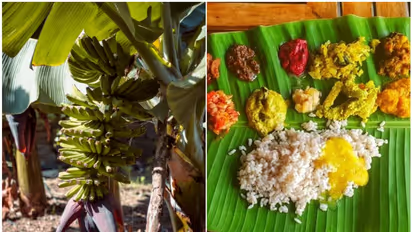Discover versatility of Banana Plant: 7 practical uses beyond the fruit

Synopsis
Explore the diverse applications of the banana plant, from food and traditional medicine to textiles and crafts. Learn about its uses in organic farming, animal feed, paper production, and more.
The banana plant, scientifically known as Musa paradisiaca, is not only famous for its delicious and nutritious fruit but also for its versatile uses. From its leaves to its stem and fruit, every part of the banana plant has practical applications. From providing food and traditional medicine to serving as a sustainable resource for textiles, crafts, and organic farming, the banana plant is truly a remarkable and versatile plant with numerous applications.
Let's explore seven common uses of the banana plant:
1. Food:
Bananas are one of the most widely consumed fruits globally, and they offer numerous health benefits. They are rich in potassium, dietary fiber, and vitamins B6 and C. People enjoy eating bananas raw, adding them to smoothies, using them in baking and cooking, and drying them as banana chips. In many cultures, banana leaves are also used as a natural and biodegradable alternative to plates or food wraps.
2. Textiles and Crafts:
Banana fibers extracted from the plant's stem are used to create textiles and crafts. The process involves stripping the outer layers of the stem to access the long fibers within. These fibers are then spun into yarn or woven into fabrics. The resulting material, known as banana fiber or banana silk, is lightweight, eco-friendly, and has a natural sheen. It is used to make garments, accessories, paper, and decorative items.
3. Traditional Medicine:
In traditional medicine systems like Ayurveda, various parts of the banana plant are used for their medicinal properties. For example, the sap of the stem is believed to have antibacterial and anti-inflammatory effects, and it is used to treat skin conditions like eczema and psoriasis. Additionally, banana flowers and roots are used to address ailments such as menstrual disorders, ulcers, and digestive issues.
4. Organic Fertilizer:
Banana plants are considered excellent sources of organic fertilizer. The peels, leaves, and stems of the plant can be composted to create nutrient-rich compost that benefits other plants. Banana peel compost is particularly high in potassium, phosphorus, and calcium, which promote healthy plant growth. This organic fertilizer is often used in gardening and farming to improve soil quality and boost crop yields.
5. Traditional Crafts and Construction:
In some regions, banana stems and leaves are used in traditional crafts and construction. The sturdy stems can be used as building material for lightweight structures like fences, huts, or furniture. The broad and flexible leaves are woven or braided into baskets, mats, hats, and other handicrafts. These traditional crafts showcase the plant's versatility and its integration into local cultures.
6. Animal Feed:
Banana plants have potential as a nutritious feed source for livestock. The leaves, stems, and pseudostem (the succulent part that resembles a trunk) can be fed to animals such as cows, goats, and rabbits. They are rich in minerals, proteins, and fiber, making them a valuable addition to animal diets. Banana leaves are also used as forage or bedding material for livestock.
7. Paper and Packaging:
Banana fibers, along with other natural fibers, are used in the production of environmentally friendly paper and packaging materials. The fibers are processed and blended with recycled paper or other fibers to create a strong, sustainable alternative to conventional paper. Banana fiber packaging, such as boxes and trays, is increasingly used as an eco-conscious choice for various industries.
Explore the latest Lifestyle News covering fashion, wellness, travel, Food and Recipes, and more. Stay updated with trending Health News, fitness tips, and expert insights to inspire your daily living. Discover personalized lifestyle trends that keep you stylish and informed. Download the Asianet News Official App from the Android Play Store and iPhone App Store for everything that adds value to your everyday life.